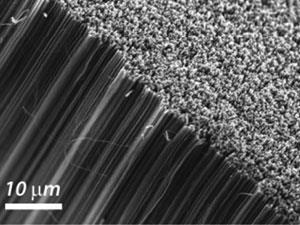
Carbon nanotubes (CNTs) have wide ranging electrochemical applications for sensing and energy. Forests of vertically aligned CNTs have been proposed for use as electrodes, but it was thought that the inert sidewalls would have to be insulated and the ends opened to allow electron transfer.
Scientists from the University of Warwick have now challenged this position by showing that the sidewalls and closed ends of CNTs can support fast electron transfer.
Julie Macpherson, Patrick Unwin and co-workers used chemical vapour deposition to grow dense forests of pristine closed-end CNTs. They then applied a new nanoscale technique to investigate specific sites on CNTs within the forest. The technique uses a tiny electrochemical cell created by filling a double-barrelled nanopipette with a solution of electrolyte and redox species, and flowing a current between the barrels. This allowed them to study the nanotubes without having to cut or process them. They found that both the sidewalls and closed ends could efficiently transfer electrons.
As well as being of fundamental interest for understanding CNTs’ electrochemistry, the finding opens up the potential for CNTs of any configuration to be used as electrodes, and means that they do not have to be modified, such as having the ends opened. ‘We hope that this will get people thinking differently about the electrochemistry of carbon nanotubes and appreciate that the whole surface can transfer electrons very efficiently,’ says Macpherson.
‘This is a very interesting and exciting paper,’ commented Gareth Keeley, an expert in the electroanalytical applications of CNTs from Trinity College, Dublin, Ireland. He is concerned, though, that the debate over the electrochemistry of CNTs will rage a while longer, feeling that the ‘claim to overturn the consensus on the importance of open ends is unlikely to gain wide acceptance until the same results can be demonstrated using inner-sphere redox probes’.
Macpherson and Unwin's team is now working on very sensitive electrochemical sensors composed of low-density planar nanotubes on insulating surfaces.
References
- T S Miller et al, Chem. Commun., 2012, DOI: 10.1039/c2cc32890a






No comments yet